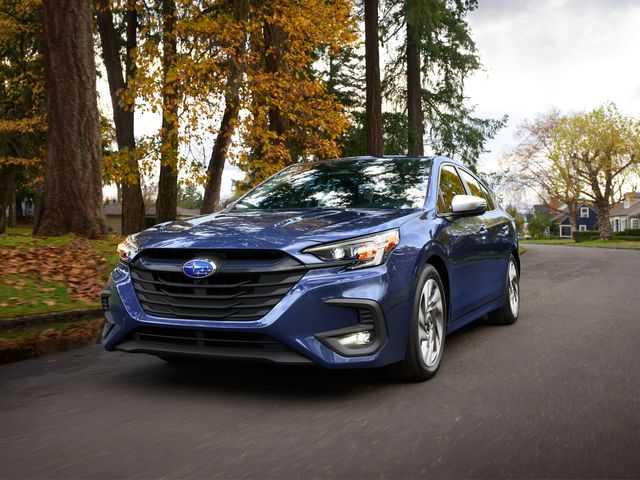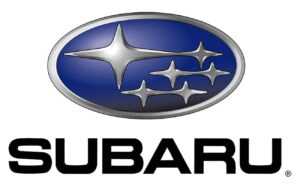Subaru Legacy 2023 Reverse Automatic Braking
Reverse Automatic Braking (RAB), a cutting-edge safety device intended to improve protection while reversing, is standard on the 2023 Subaru Legacy. This technology uses sensors around the back of the car to identify possible obstructions. If it senses an impending accident, it immediately applies the brakes to stop or lessen the impact. Designed primarily for low-speed situations like parking or reversing in confined spaces, the RAB system adds a crucial layer of safety by alerting the driver both visually and audibly before using the brakes. This function, which is a part of Subaru’s extensive array of driver-assist technologies, demonstrates the brand’s dedication to safety and driver confidence, especially in difficult or crowded driving situations.
2024 Subaru Legacy Specs, Price, Features, Mileage (Brochure)
Reverse Automatic Braking (RAB) System (If Equipped)
Reverse Automatic Braking (RAB) is a system designed to help avoid collisions or reduce collision damage when reversing the vehicle. If a wall or an obstacle is detected in the reversing direction, the system will notify the driver with a warning sound and may activate the vehicle’s brakes automatically.
WARNING
- Reverse Automatic Braking (RAB) is not a system intended to replace the driver’s responsibility to check their surroundings for vehicles or obstacles to avoid a collision.
- The driver is responsible for driving safely. Before reversing, be sure to first depress the brake pedal and visually check the surroundings.
- There are some cases in which the vehicle cannot avoid collision, because the system operation has limitations. The warning sound or automatic braking may be delayed or may not operate at all even when an obstacle is present.
- Make sure to set the Automatic Braking function to OFF when the vehicle is on the free roller or on the chassis dynamometer. Otherwise, the vehicle may move and it may cause an accident.
- Make sure to set the Automatic Braking function to OFF when towing a trailer. Otherwise, the vehicle may move and it may cause an accident.
- The system is not designed to detect people (including children), animals, or other moving objects.
- Depending on the vehicle condition or the surrounding environment, the sonar sensor’s ability to detect objects may become unstable.
NOTE
The Reverse Automatic Braking (RAB) system records and stores the following data when automatic braking operates. It does not record conversations, personal information or other audio
Data.
- Distance from the object
- Vehicle speed
- Accelerator pedal operation status. Brake pedal operation status
- Select lever position
- Outside temperature
- The sensitivity setting of the sonar sensors
SUBARU and third parties contracted by SUBARU may acquire and use the recorded data for the purpose of vehicle research and development. SUBARU and third parties contracted by SUBARU will not disclose or provide the acquired data to any other third party except under the following conditions. - The vehicle owner has given his/her consent.
- The disclosure/provision is based on a court order or other legally enforceable request.
- Data that has been modified so that the user and vehicle cannot be identified is provided to a research institution for statistical processing or similar purposes.
Reverse Automatic Braking (RAB) System Overview
The Reverse Automatic Braking (RAB) system will operate the following 2 functions using 4 sonar sensors.
- Sonar Audible Alarm function
The Reverse Automatic Braking (RAB) system detects objects rearward and warns the driver by warning message on the center information display and warning beeps. - Automatic Braking function
The Automatic Braking function detects objects rearward and if there is a high risk of a collision, the system decelerates the vehicle and controls the braking to reduce damage.

- When reversing
- When either strong automatic braking or torque control is applied to prevent collision (in this case, short warning beeps or continuous warning beeps will sound)
- When the vehicle is stopped by the system (in this case, the continuous beep will remain sounding)
- Object (e.g., a wall)
Detecting range

- Detecting range (width): Approximately 6 in (15 cm) outside of the vehicle width
- Range that the system cannot detect: Approximately 20 in (50 cm) behind the rear of the vehicle
- Detecting range (length): Approximately 5 ft (1.5 m) from the rear of the vehicle
WARNING
If your vehicle is trapped on a railroad crossing and you are trying to escape by reversing through the crossing gate, the system may recognize the crossing gate as an obstacle and the brake may activate. In this case, remain calm and either continue to depress the accelerator pedal or cancel the system.
Operating Conditions
The Reverse Automatic Braking (RAB) system will operate when all of the following conditions are met.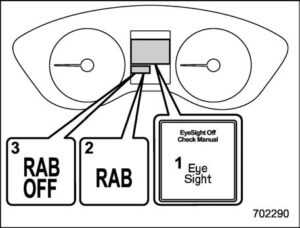
- EyeSight warning indicator
- RAB warning indicator
- RAB OFF indicator
- The ignition switch is in the “ON” position.
- The EyeSight warning indicator is off.. The RAB warning indicator is off.
- The RAB OFF indicator is off.
- The select lever is in the “R” position.
Sonar Audible Alarm function - The Sonar Audible Alarm is set to “ON”. The vehicle speed is from 0 to 9 mph (0 to 15 km/h).
Automatic Braking function - The Automatic Braking is set to “ON”. The vehicle speed is from 1 to 9 mph (1.5 to 15 km/h).
NOTE
- In the following cases, the Reverse Automatic Braking (RAB) system will not operate. Promptly contact a SUBARU dealer to have the system inspected.
- The EyeSight warning indicator is illuminated.
- The RAB warning indicator is illuminated.
- In the following cases, the Reverse Automatic Braking (RAB) system cannot be operated.
- The (EyeSight Temporary Stop indicator: White) is illuminated, and the messages corresponding to the EyeSight temporary stop are displayed on the combination meter display (color LCD). For details, refer to the Owner’s Manual Supplement for the EyeSight system.
- The RAB OFF indicator is illuminated.
- In the following cases, the functions may not be able to properly work. Promptly contact a SUBARU dealer to have the system inspected.
- A sticker, paint, or a chemical is applied to the sonar sensors or the rear bumper near the sonar sensor.
- The rear bumper is modified.
- The rear bumper has been removed and attached.
- The ground clearance is changed due to the vehicle’s loading condition or modification.
- There is damage to the sonar sensors or the rear bumper near the sonar sensor.
- The rear bumper is exposed to strong impact, or the rear bumper is deformed.
- On a steep hill, the system’s automatic braking ability will be reduced. The system is designed to avoid collisions by automatic hard braking when the vehicle’s reversing speed is less than approximately 3 mph (5 km/h). However, the system does not guarantee that the vehicle will be able to avoid collisions in any situation.
- If the vehicle is reversed at an extremely slow speed, the driver’s operation may be prioritized. In this branch or railroad crossing bars are present in the reversing direction.
- When reversing on a gravel or grassy area.
- When reversing in an area where objects or walls are adjacent to the vehicle such as narrow tunnels, narrow bridges, narrow roads, or narrow garages.
- A wheel track or hole is present in the ground of the reversing direction.
- When reversing over a drainage cover (grating cover).
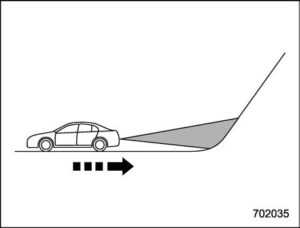
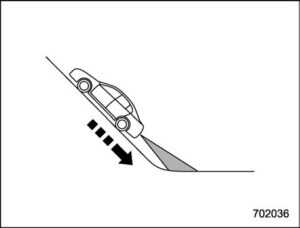
-
- The path of the reversing direction is inclined such as on a steep uphill.
- When reversing downhill.

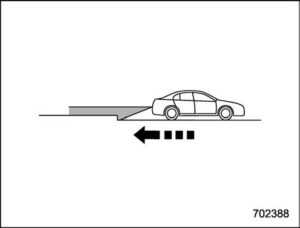
-
- Reversing in a garage with a low ceiling or a tunnel.
- There is a patch of snow rearward.
- There is a puddle of water.
- There is an obstacle that is next to an object.
- Going back along a wall.
- The area where the road starts touching dirt and snow
- When reversing on an uneven road.
- In circumstances such as the following, it may not be possible to avoid a collision even when the system operates normally.
- Roads are slippery.
- The tire air pressure is not correct.
- The tires have become worn.
- Tire chains are installed.
- Tires that are not the designated size are installed.
- Emergency repairs were performed using a puncture repair kit.
- The suspension was modified.
- Vehicle driving is unstable due to an accident or malfunction.
- The brake warning light is illuminated.
Sonar Audible Alarm Function
When the Reverse Automatic Braking (RAB) system is in operation, an audible warning beep will sound in 3 levels to warn the driver of a potential collision.
NOTE
It may take time to display the wall and sound warning beeps after the object is recognized by the Sonar Audible Alarm.
Guideline of detecting range
| Alert level | Range of detected object* | Distance indicator | Alarm pattern |
| Long proximity (object detected) | 35 in (90 cm) or more | Green | No warning sound |
| Medium proximity alert (approaching the object) |
28 to 35 in (70 to 90 cm) |
Yellow | Short beeps |
| Short proximity alert (approaching closer to the object) | 20 to 28 in (50 to 70 cm) | Orange | Rapid short beeps |
| Closest proximity alert (too close to the object) | 20 in (50 cm) or less | Red | Continuous beep |
The range of detection may vary depending on the environmental condition.
Obstacle detected and alert level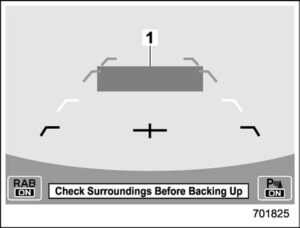
Long proximity alert (object detected)
- 35 in (90 cm) or more
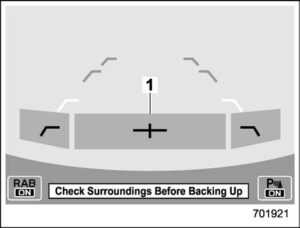
Medium proximity alert (approaching the object)
- Yellow: 28 to 35 in (70 to 90 cm)

Short proximity alert (approaching the object closer)
- Orange: 20 to 28 in (50 to 70 cm)
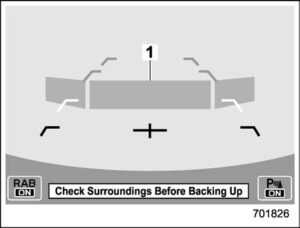
Closest proximity alert (too close to the object)
- Red: 20 in (50 cm) or less
When an object is detected in the reversing direction, the range of the detected object will be shown on the center information display.
A warning alarm will sound and, depending on the speed, either torque control to generate engine braking or automatic braking will be applied.
Automatic Braking Function Operation
Object close behind the warning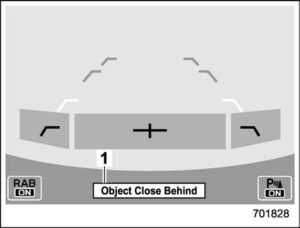
Automatic braking warning
- Warning message
If the system determines the risk of collision with the object. Short warning beeps or continuous warning beeps will sound and either strong automatic braking or torque control will be applied to prevent a collision. At this time, a warning message is also displayed on the combination meter display (color LCD).
Depress brake pedal warning
- Warning message
Make sure to depress the brake pedal once the vehicle has been stopped by automatic braking. Until the brake pedal is depressed, a message will be displayed on the central information display and the continuous beep will remain sounding. At this time, a warning message is also displayed on the combination meter display (color LCD).
NOTE
The Sonar Audible Alarm function and Automatic Braking function are different in operation conditions. Therefore there are cases in which only one of these functions will activate.
WARNING
Depress the brake pedal immediately after the system stops the vehicle by automatic braking. Depending on the conditions of the road surface and tires, the vehicle may not remain stopped, possibly leading to an accident..
After the vehicle is stopped by the system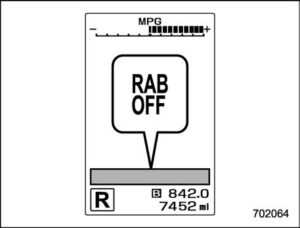
After the brake pedal is depressed, the RAB OFF indicator will illuminate and the system will temporarily stop operating. The RAB OFF indicator will turn off when the select lever is shifted to a position other than the “R” position. The system will operate again the next time the select lever is shifted to the “R” position.
NOTE
- In the following cases, after the vehicle has been stopped by the Re-verse Automatic Braking (RAB) system, brake control is released and the electronic parking brake operates. For details about releasing the parking
- Always keep the sonar sensor and the rear bumper surface near the sonar sensors clean.
- Do not modify the rear bumper.
- Do not paint the bumper near the sonar sensors.
- Do not apply high-pressure water to the sonar sensors with a high-pressure car-washing machine.
- Do not apply strong impacts to the rear bumper near the sonar sensors. If a sensor becomes misaligned, a system malfunction may occur, including the inability to detect objects in the reversing direction. If any strong impact is applied to the rear bumper, contact a SUBARU dealer to have the system inspected.
- Do not disassemble the sonar sensors.
NOTE
If the sonar sensors require repair or replacement, or if the area of the rear bumper near the sonar sensors requires repair, paintwork, or replacement, contact your SUBARU dealer for assistance.
FAQ
Reverse Automatic Braking is a safety feature that helps prevent collisions when the vehicle is in reverse by automatically applying the brakes if an obstacle is detected.
The system uses sensors located around the rear of the vehicle to detect obstacles in the car’s path when reversing.
RAB typically functions at low speeds, commonly in parking lot scenarios or during backing maneuvers.
Yes, drivers can deactivate the RAB system via controls in the vehicle, typically found on the dashboard or through the infotainment system.
While RAB is focused on directly preventing collisions by braking, the rear cross-traffic alert warns drivers of approaching traffic from the sides when reversing but doesn’t automatically brake.
The availability of RAB varies by trim level and package options. It might not be standard on base models.
The system typically issues audible beeps and visual alerts on the display to warn the driver of an impending collision.
RAB’s effectiveness can be influenced by weather conditions. Heavy rain, snow, or fog might impair sensor accuracy.
It can detect a range of obstacles, including vehicles, walls, and in some cases, pedestrians.
Yes, if the vehicle is reversing above a certain low-speed threshold (specific to the vehicle), RAB may not engage to avoid abrupt and potentially unsafe braking.
RAB is part of Subaru’s suite of safety features and works in tandem with others, like the rearview camera and parking sensors, for comprehensive safety.
While effective, RAB is not foolproof and may not prevent all collisions, especially with small or fast-moving objects.
An indicator light on the dashboard or a message on the infotainment display typically shows when RAB is active.
The system may have limitations, like reduced effectiveness on steep inclines, with certain types of obstacles, or in poor visibility conditions.
It greatly assists in parking and reversing situations, reducing the risk of low-speed collisions, especially in tight spaces.
Useful Link
View Full User Guide: Subaru Legacy 2023 Touring XT User Guide
Download Manuals: https://www.subaru.com/owners/vehicle-resources/manuals.html
2024 Subaru Legacy Specs, Price, Features, Mileage (Brochure)

